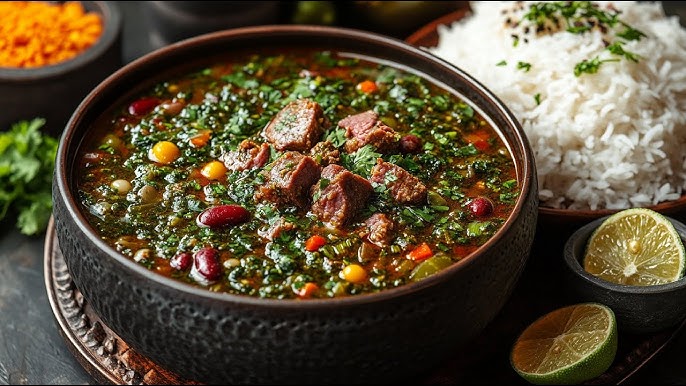Ghormeh Sabzi Recipe: If there is one dish that defines Persian cuisine and stands as the heart of many Iranian households, it’s Ghormeh Sabzi. Known as the national dish of Iran, this herb stew carries layers of rich, earthy, tangy, and savory flavors that bring families together at the dinner table. Cooking Ghormeh Sabzi is not just about making a stew—it’s about preserving tradition, showcasing patience, and appreciating the art of slow cooking.
In this guide, we’ll walk you through everything you need: from the fresh ingredients to the step-by-step cooking process. By the end, you’ll not only have learned the secrets behind this authentic dish but also mastered how to make it in your own kitchen, even if it’s your very first time.
What is Ghormeh Sabzi?
Ghormeh Sabzi is a traditional Persian herb stew that has been cooked for centuries. The name itself tells you what to expect: “Ghormeh” means braised or stewed, and “Sabzi” means herbs. Together, they form a dish that celebrates the bold flavors of fresh greens, tender meat, tangy dried limes, and hearty beans.
This dish is famous for its dark green color, achieved by slowly frying a generous amount of fresh herbs until they release their aroma and deep flavors. The stew simmers for hours, allowing the dried limes to infuse their unique sour taste and the meat to become melt-in-your-mouth tender. Served over fluffy saffron rice, Ghormeh Sabzi isn’t just food—it’s comfort on a plate.
The Cultural Significance of Ghormeh Sabzi in Persian Cuisine
For Iranians, Ghormeh Sabzi is more than a meal. It’s a symbol of home, hospitality, and identity. Many families cook this stew on Fridays, the Iranian weekend, when everyone gathers around the table. It’s often the centerpiece of special occasions, family reunions, and celebrations.
Interestingly, every region in Iran has its own small twist on Ghormeh Sabzi. Some prefer it with kidney beans, while others swap them for black-eyed peas. Some regions make it slightly tangier, while others use more herbs for a greener color. But at its core, the dish remains the same: a deeply aromatic, hearty, and soulful stew.
Ingredients You’ll Need
The magic of Ghormeh Sabzi lies in its ingredients. While it looks like a humble herb stew, each element plays an important role in achieving the authentic taste.
Fresh Herbs
The heart of Ghormeh Sabzi is its herbs. The classic mix includes:
- Parsley – The base herb that gives the stew its earthy depth.
- Cilantro (Coriander) – Adds a subtle citrusy freshness.
- Chives or Green Onions – Introduce a mild onion flavor.
- Fenugreek Leaves (fresh or dried) – The game-changer; adds a slightly bitter, aromatic taste that defines the dish.
All herbs must be washed thoroughly, finely chopped, and then fried until dark green. This step is what sets Ghormeh Sabzi apart from any other stew.
Protein Choices (Beef, Lamb, or Vegetarian Options)
Traditionally, Ghormeh Sabzi is made with lamb or beef, cut into medium cubes. The meat should be fatty enough to enrich the stew but not so much that it becomes greasy. If you don’t eat meat, you can still enjoy this dish by using mushrooms or tofu as substitutes, creating a vegetarian version that still carries the authentic flavors.
Essential Spices and Seasonings
Persian food isn’t about fiery spices but rather about balance. For Ghormeh Sabzi, you’ll need:
- Turmeric – Adds warmth and color.
- Salt and Black Pepper – The basics for seasoning.
- Optional Saffron – A luxurious addition that enhances aroma.
Other Key Ingredients
- Kidney Beans (or black-eyed peas in some regions) – Provide heartiness and texture.
- Dried Limes (Limoo Amani) – The soul of the dish, adding a distinct sourness.
- Cooking Oil – Used for frying herbs.
- Onion – To sauté with the meat for a strong flavor base.
- Water or Broth – For slow simmering.
These simple ingredients come together to create a stew so flavorful that one bite will convince you why it’s called Iran’s national treasure.
Preparing the Ingredients
Before you start cooking, preparation is key. Ghormeh Sabzi is a labor of love, and rushing through the steps can affect the final result.
Washing and Chopping Herbs Properly
Herbs must be washed multiple times to remove dirt and grit. After washing, let them dry completely; otherwise, they’ll steam instead of frying. Once dry, chop them finely—this ensures they fry evenly and release maximum flavor.
The frying process is crucial. The herbs should turn dark but not burn. This step requires patience, as it brings out the deep, earthy flavor that defines Ghormeh Sabzi.
Preparing the Meat for the Stew
If you’re using beef or lamb, cut it into bite-sized cubes. Trim off any excess fat, but leave a little for richness. Season lightly with turmeric, salt, and pepper. When seared properly, the meat should lock in juices and create a flavorful base for the stew.
Handling and Using Dried Limes
Dried limes (limoo amani) are the secret ingredient that gives Ghormeh Sabzi its tang. To use them, pierce each lime with a fork or knife before adding them to the stew. This allows the flavors to seep into the broth slowly. Some cooks even soak the limes in warm water for 10 minutes to soften them.
Prepping Kidney Beans or Substitutes
If you’re using dried kidney beans, soak them overnight. This helps them cook faster and prevents digestive discomfort. If you’re short on time, canned beans work fine, but add them toward the end to avoid overcooking.
Step-by-Step Guide to Cooking Ghormeh Sabzi
Step 1: Frying the Herbs
Start by heating oil in a large pan. Add your chopped herbs and stir continuously until they darken and release a rich aroma. This step may take 10–15 minutes, but it’s worth every second. The herbs should look glossy and deep green, not burnt.
This process not only develops the unique flavor but also prevents the stew from tasting grassy or raw. If you’ve ever had Ghormeh Sabzi that tasted flat, chances are the herbs weren’t fried properly.
Step 2: Searing the Meat
Once your herbs are ready, it’s time to move on to the protein. In a large pot, heat some oil and sauté chopped onions until golden. Add the meat cubes and sprinkle with turmeric. Stir well until the meat browns on all sides. This browning step is essential—it creates a savory depth that forms the backbone of your stew’s flavor.
Don’t rush this process. Browning meat properly means you’re locking in juices and building a rich flavor base. At this point, your kitchen will already smell amazing—the aroma of sautéed onions and turmeric mixing with the browning meat is the first sign that your Ghormeh Sabzi is on the right track.
Step 3: Combining Herbs, Meat, and Spices
Now comes the magical moment when the two stars—fried herbs and browned meat—finally meet. Transfer your sautéed herbs into the pot with the meat and onions. Stir thoroughly so the herbs coat every piece of meat. Add a pinch of salt and black pepper, adjusting later as it cooks.
Pour in enough water (or broth for extra richness) to cover the mixture by a couple of inches. This will be your stew base. Once the pot comes to a gentle boil, lower the heat to medium and let it simmer slowly. This is when the flavors begin to merge into the deep, complex taste Ghormeh Sabzi is famous for.
Step 4: Adding Beans and Dried Limes
After about 30 minutes of simmering, it’s time to add your beans. If you’re using soaked dried beans, add them now so they can cook with the stew. If you’re using canned beans, wait until later so they don’t become mushy.
Next, prepare your dried limes. Poke a few holes in each one with a fork or knife, then drop them into the stew. As they simmer, they release a tangy, citrus-like flavor that balances the richness of the meat and herbs. This step is what elevates Ghormeh Sabzi from a simple herb stew to a uniquely Persian masterpiece.
Step 5: Slow Simmering for the Perfect Flavor
Now comes the hardest part: waiting. Ghormeh Sabzi must simmer slowly for at least 2–3 hours. The longer it cooks, the richer and more balanced the flavors become. Stir occasionally and check if the water level is enough—add more hot water if necessary to keep the stew from drying out.
As the stew simmers, the herbs deepen in color, the beans soften, and the meat becomes tender enough to fall apart with a fork. By the end, the stew should have a slightly thick consistency with a deep green-brown color. The aroma will be irresistible, filling your kitchen with the essence of Persian comfort food.
Tips for the Perfect Ghormeh Sabzi
Every Persian household has its own little tricks for making Ghormeh Sabzi unforgettable. Here are some tips to help you get it right every time.
Common Mistakes to Avoid
- Burning the herbs – Overfrying makes them bitter; underfrying makes the stew bland. Find the perfect balance.
- Adding too many dried limes – They can make the stew overly sour. Stick to 2–3 for a medium pot.
- Cooking on high heat – Ghormeh Sabzi is about slow cooking. Rushing will ruin the depth of flavor.
Adjusting the Taste to Your Preference
If your stew tastes too bitter, remove one dried lime or add a teaspoon of lemon juice for a brighter flavor. If it feels too sour, balance it with a small pinch of sugar. Remember, Ghormeh Sabzi is flexible—it’s all about balance.
How to Thicken or Loosen the Stew
- If your stew is too watery, let it simmer uncovered for another 20–30 minutes.
- If it’s too thick, add a little hot water or broth to loosen it.
The goal is a stew that is neither soupy nor dry but has a rich, slightly thickened broth that clings beautifully to rice.
Serving Suggestions
Ghormeh Sabzi is rarely enjoyed on its own—it almost always comes with its perfect partner: Persian rice (Chelow). The stew’s rich, herbaceous broth pairs beautifully with the fluffy, aromatic basmati rice, especially when topped with golden, crispy tahdig (the famous crunchy rice crust). Each spoonful of rice soaks up the savory-sour sauce, balancing the richness of the meat and herbs.
You can serve Ghormeh Sabzi in a large communal dish, family-style, or in individual bowls with rice on the side. Garnishes are not common, but some people like to sprinkle a little saffron water on the rice or serve the stew with fresh herbs and flatbread for variety.
As for drinks, many Iranians enjoy doogh (a yogurt-based drink with mint) alongside Ghormeh Sabzi, which complements its tangy notes. Fresh salads like Shirazi salad (a cucumber, tomato, and onion salad with lime dressing) also work well as a refreshing side.
When serving guests, Ghormeh Sabzi often takes center stage in a multi-course Persian meal, alongside kebabs, stews, and mezze-style appetizers. But even on its own, paired with rice, it remains a complete, hearty, and satisfying dish.
Nutritional Value of Ghormeh Sabzi
Beyond its incredible taste, Ghormeh Sabzi is packed with nutrition. The combination of fresh herbs, beans, and protein makes it a wholesome meal.
- Protein: The lamb or beef provides a generous protein boost, essential for muscle repair and energy.
- Fiber: Kidney beans add a healthy dose of dietary fiber, improving digestion and keeping you full longer.
- Vitamins & Minerals: Fresh herbs like parsley and cilantro are loaded with vitamin K, vitamin C, and antioxidants. Fenugreek leaves also provide iron and magnesium.
- Healthy Fats: When cooked with moderate oil, Ghormeh Sabzi offers heart-healthy fats that enhance nutrient absorption.
- Low in Spices: Unlike many stews, Ghormeh Sabzi isn’t heavy on spices, making it gentle on the stomach while still being deeply flavorful.
Overall, this dish is both comforting and nourishing—a perfect example of how Persian cuisine blends taste with health.
Variations of Ghormeh Sabzi
One of the beauties of Ghormeh Sabzi is its versatility. While the traditional recipe is the most loved, there are several ways to adapt it to different diets and regional preferences.
Vegetarian or Vegan Ghormeh Sabzi
For a plant-based version, simply omit the meat and increase the amount of beans. Mushrooms, tofu, or seitan can also be used for texture. The stew retains its signature flavors because the herbs and dried limes remain the stars of the dish.
Regional Variations Across Iran
- Southern Iran: Often uses black-eyed peas instead of kidney beans.
- Northern Iran: May include extra herbs for a greener, fresher flavor.
- Urban households: Sometimes add extra saffron for a luxurious twist.
Modern Adaptations
Today, many people make Ghormeh Sabzi in slow cookers or instant pots to save time. While purists prefer the stovetop method, these tools can still create delicious results with less effort. Some cooks even freeze pre-fried herbs to speed up the process when craving a quick stew.
Storage and Reheating Tips
One of the best things about Ghormeh Sabzi is that it tastes even better the next day. The flavors continue to deepen as the stew sits, making leftovers a real treat.
- Refrigeration: Store in an airtight container for up to 4 days.
- Freezing: Ghormeh Sabzi freezes beautifully. Portion it into freezer-safe containers and store for up to 3 months. Thaw overnight in the fridge before reheating.
- Reheating: Always reheat on low heat to prevent the herbs from overcooking or burning. Add a splash of water or broth if the stew has thickened too much.
With these tips, you can prepare a big batch and enjoy it throughout the week—or freeze some for busy days when you need comfort food without the effort.
FAQs about Ghormeh Sabzi Recipe
1. Can I cook Ghormeh Sabzi in a slow cooker?
Yes! You can sauté the herbs and meat separately, then transfer everything into a slow cooker and let it cook on low for 6–8 hours.
2. What if I can’t find dried limes?
You can substitute with lime juice or lemon juice, but the flavor will be slightly different. Some people use a bit of tamarind for a similar tang.
3. How long should I cook the stew?
Ideally, 2–3 hours on low heat. The longer it simmers, the deeper the flavor.
4. Can I replace kidney beans with other beans?
Yes, black-eyed peas or pinto beans are common substitutes depending on the region.
5. How do I make Ghormeh Sabzi less bitter?
Reduce the amount of fenugreek or dried limes, and balance the taste with a small pinch of sugar or extra lemon juice.
Conclusion
Ghormeh Sabzi isn’t just another stew—it’s a journey through Persian culture, flavors, and traditions. From its aromatic mix of herbs to the tang of dried limes and the tenderness of slow-cooked meat, every bite tells a story. It requires patience, love, and care, but the reward is a dish that warms both body and soul.
Whether you stick to the traditional recipe or try a modern variation, making Ghormeh Sabzi at home is a way to connect with one of the world’s oldest culinary heritages. Serve it with Persian rice, share it with family, and let the flavors speak for themselves.



